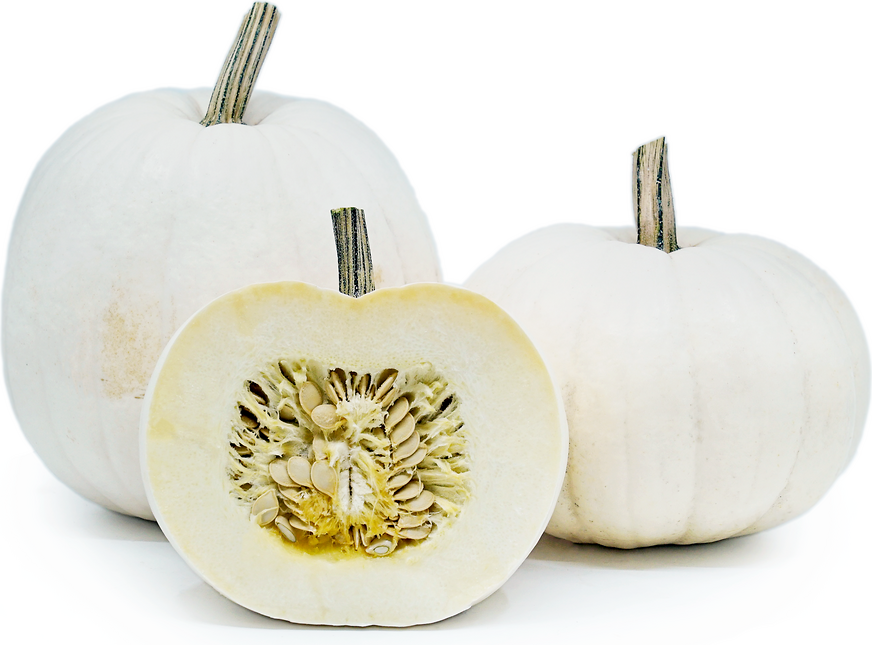


Pumpkins Lumina (White)
Estimated Inventory, 24" Bin : 0
This item was last sold on : 11/27/24
Description/Taste
Lumina pumpkins are typically medium-sized but can vary in proportion, measuring anywhere from about 20 to 25 centimeters wide, 25 to 46 centimeters tall, and weighing between 3.5 to 7 kilograms. They can have a globular, uniform, or round shape with shallow ribbing or a squat and slightly flattened shape with more pronounced ribbing. Lumina pumpkins have an ivory-colored rind that's smooth, hard, and matte. This thick rind requires a knife to slice through and is attached to a stem with white and dark green stripes. When sliced in half lengthwise, the thick outer flesh of the pumpkin is revealed to be either a sherbert orange or creamy-white hue with a dense, fine-grained texture. This flesh encases a central cavity filled with stringy pulp and flat, cream-colored seeds. Lumina pumpkins have a tender texture with a mild, earthy, and slightly sweet flavor.
Seasons/Availability
Lumina pumpkins are available from fall to early winter.
Current Facts
Lumina pumpkins are botanically classified as Cucurbita maxima and are members of the Cucurbitaceae family, which also includes gourds, melons, squashes, and cucumbers. This variety grows on long trailing vines and does well when planted alongside crops like corn, pole beans, sunflowers, and other vine-grown vegetables. Lumina pumpkins are one of several white pumpkin varieties, alongside Ghost, Full Moon, Valenciano, Silver Moon, and Casper pumpkins. Originally thought to be a field mutation of orange pumpkins, white pumpkins like the Lumina have increased in popularity and are being specifically bred for their ivory hues. They are commonly used as ornamental decorations for fall displays and carving pumpkins but can also be incorporated into culinary preparations.
Nutritional Value
Lumina pumpkins are rich in vitamins A, C, and B. Vitamin A, especially in the form of beta-carotene, promotes good vision and skin health, while vitamin C boosts immunity and aids in collagen production. Their B vitamins, including niacin, thiamine, and folate, contribute to energy metabolism, nervous system function, and cell repair. Lumina pumpkins provide essential minerals like iron and magnesium, which are crucial for red blood cell production and muscle function. They also contain phosphorus, vital for bone health, and lutein and zeaxanthin, antioxidants that protect eye health.
Applications
White pumpkin varieties like Lumina can be used in many of the same ways as orange pumpkins but offer a milder flavor. This variety is not eaten raw but is well suited for baking, roasting, and boiling. They are often cubed and added to pumpkin chilis, soups, and curries. When puréed, this variety may be incorporated into pasta dishes like risotto, mac and cheese, lasagna, ravioli, bacon carbonara, and bolognese. Lumina pumpkins' slightly sweet flavor enhances baked goods like challah bread, dinner rolls, pies, empanadas, pastries, and cornbread. They may also work well in salads, vegetable bakes, quinoa bowls, enchiladas, quesadillas, hummus, and tomato sauces. Lumina pumpkins complement the flavors of cinnamon, nutmeg, cloves, cardamom, rice, quinoa, cranberries, walnuts, hazelnuts, pine nuts, peanuts, sausage, chicken, turkey, mushrooms, broccoli, garlic, onions, sage, and thyme. They will keep for 1 to 3 months when stored in a cool, dry place.
Ethnic/Cultural Info
In North America, white pumpkins have increased in popularity during the last thirty years due to changing decorative preferences. There has been a growing demand for non-orange varieties to display for Halloween parties and carving. As the demand increases, more farms are creating different cultivars and are able to obtain a higher price for the exclusiveness of these unique pumpkins. White pumpkins are used in do-it-yourself projects such as painting pumpkins, drawing jack-o-lantern faces onto the surface, or hollowing out and using the pumpkin as a candle holder. White pumpkins are also frequently incorporated into fall wedding decorations.
Geography/History
Lumina pumpkins were developed in 1990 by George Perry & Sons and the Hollar Seed Company. The idea behind their conception was to keep up with consumer demands for more novelty pumpkins to decorate with during the Halloween season. These pumpkins are best suited for warm and hot climates with temperatures ranging from about 16 to 32 degrees Celcius. This variety is not sourced from the wild as they are a cultivated breed that must be carefully grown commercially or in home gardens. White pumpkins like the Lumina gained popularity in the 1980s and 1990s when farmers began intentionally developing albino pumpkin seeds that produced white rinds. They continued to be well-liked by the public into the 2000s when they were increasingly used in fall decor. This variety is popular in the United States and Canada, where they may be sold from seeds at nurseries or offered during the fall at farms, farmers’ markets, and specialty stores.
Recipe Ideas
Recipes that include Pumpkins Lumina (White). One
| Roots and Leisure |
|
Ash-Gourd Coconut and Yogurt Curry |
| Heather Christo |
|
Stuffed Roasted Pumpkin |
| Monsoon Spice |
|
Ash Gourd Majjige Huli |
| Divine Taste |
|
Ash Gourd (White Pumpkin) Halva |




